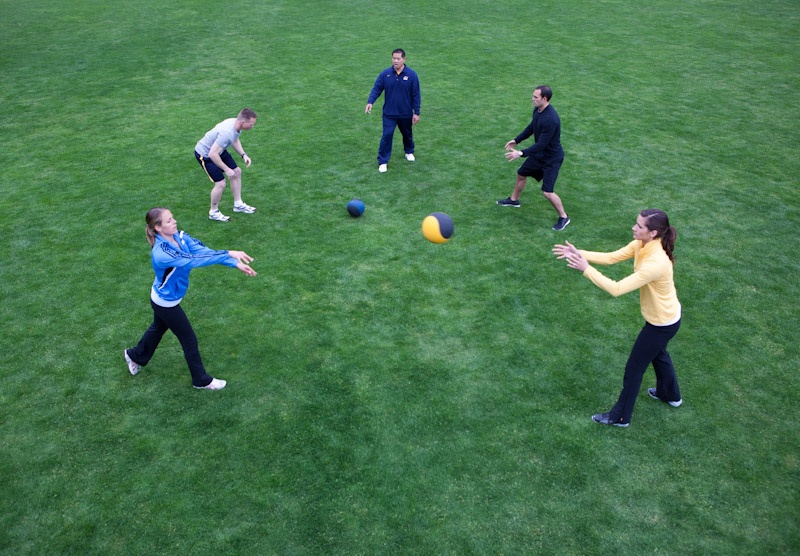

As a sports performance professional, conducting a comprehensive fitness evaluation for an athlete can be a complicated process. And it is even more complicated when working with an entire team of athletes.
Selecting the appropriate health-risk, physiological, and performance assessments to use for a sports team is ultimately determined by group size, goals, number of administrators, and available space and equipment.
While an assessment process is relevant and necessary for all athletes, it must also be convenient and time-efficient.
Let's explore this subject further!
This material is referenced and derived from the NASM Performance Enhancement Specialization Curriculum . To become an expert in Strength and Conditioning , Performance Nutrition, and other aspects of Sports Performance, sign up today!
To compound the complexity of choosing assessments, many sports entail multiple player positions with very unique physical demands. For example, football requires different demands for skill position players (wide receivers, defensive backs, quarterbacks etc.) versus linemen.
The demands of a baseball pitcher are much different than an infielder or outfielder, while soccer goalies need an entirely different skillset than forwards and midfielders. As such, the battery of tests chosen for one athlete may not be appropriate for teammates playing a different position. However, here we will explore some simple strategies for assessing athletic teams as a whole rather than by each position.
Before implementing an assessment process for your athletes it is important to determine the needs of the sport. By answering the following questions you’ll be better equipped to determine which assessments are most applicable and relevant for your athletes.
Once you have determined the needs of the sport, it becomes easier to pick and choose which assessments are the most appropriate for your athletes. In general, endurance sport athletes (i.e., triathletes) will have different needs than team sport (i.e., basketball, soccer) and power-based (football, shot-put) athletes.
As such, the assessment process should be tailored to fit the needs of the sport and athlete, while also providing the information needed to design a sports-specific conditioning program.
Regardless of the sport or group size, baseline assessments should occur before an athlete can participate in a program. To ensure that sports performance professionals are collecting relevant and effective information, they should gather subjective assessments (i.e., PAR-Q , health history questionnaires) before progressing to physiological measurements and then performance tests.
If conducting multiple assessments on the same day, a logical sequence must be followed in order to assure validity of each test. For example, circumference measurements should not be taken after exercise when an athlete is dehydrated or experiencing vasodilation due to thermoregulation, both of these events can change circumference measurements.
Nor should balance be assessed after cardiorespiratory assessments when athletes are likely fatigued. Below is a suggested sequence for assessments:
*Sample forms can be found here .
Keep in mind that conducting too many assessments may overwhelm or even bore athletes. Sports performance professionals should only administer assessments they deem necessary and relevant to outcomes and the program.
Obtaining detailed information of each athlete when working with a group of between six and 12 can be challenging. With this size of a group, the sports performance professional should complete the health-risk appraisal, then organize participants into pairs so they can work together to collect assessment information (Table 1).
Specific instructions will need to be provided on how to perform the selected assessments and how to properly record the results. For example, teaching the participants how to cue proper technique, administer the test (e.g., count correct repetitions, manage the time clock), and record data — then switch roles — will allow the assessment process to flow smoothly and in an organized manner, while enabling athletes needed recovery between any assessments that evoke fatigue.
Table 1 illustrates an example battery of assessments that can work for a group this size when organized efficiently.
 How to Assess Large-sized Teams (>12 Athletes)
How to Assess Large-sized Teams (>12 Athletes)In this case, the large numbers of athletes makes physiological assessments very challenging, especially those assessments involving higher degrees of administrative control.
The health-risk appraisal must still be conducted, ideally a few days before implementing any battery of tests. The sports performance professional can also consider implementing some basic movement patterns during a warm-up and use this opportunity to scan the group for potential muscle imbalances and faulty movement patterns.
This allows the professional to identify athletes with whom to hold a conversation about specific needs, or to provide ideas for program design for the entire group. When possible, athletes should work in pairs to help conduct fitness assessments. However, these assessments must be relatively simple to perform and administer since the sports performance professional will likely be unable to provide individual instruction and guidance (Table 2).

Designing a systematic, progressive, and integrated sports performance program can only be accomplished by developing an understanding of the athlete’s goals, needs, and abilities.
This requires the sports performance professional to administer a battery of tests in a safe and organized fashion. Assessments can range from detailed and formal to brief and informal, based upon group size, time available, and other logistics. Assessment processes include the collection of subjective information (i.e., health-risk appraisal) and objective information (i.e., movement screens and performance tests).
The physiological assessments can include the examination of musculoskeletal alignment, movement efficiency, and multiple parameters of physical fitness. While a health-risk appraisal is absolutely necessary to evaluate risk of exercise, the selection and sequence of the physiological assessments should be manageable, relevant, appropriate, and valid, and should consider the needs of both the sport and athlete.